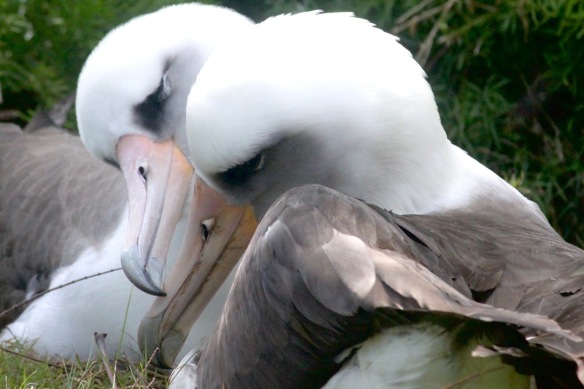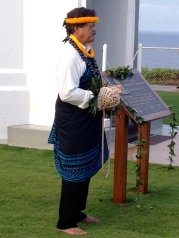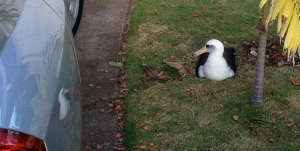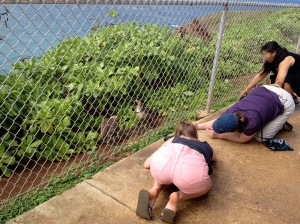KP338 and KP643, or Click and Clack respectively as Steve and I have chosen to name them (unofficially), have been nesting in or near our yard for over 10 years, long before we bought this home in 2011.

Click (KP338) and Clack (KP643)
Click and Clack are a long-term dedicated female-female couple; however, they have raised chicks in the past, mostly adoptive eggs from PMRF [hereʻs an excellent article explaining the PMRF adoption program], or from a neighboring failed nest, and sometimes because a randy male made ‘contact’ with one or other or both when they arrived on island.
In our neighborhood this year we have a number of female-female couples who have successfully hatched a chick, including one pair who have been successful more often than not. Check out my neighbor Cathy’s post at: https://albatrossdiary.com/2018/01/30/6723/ **
For the first time, we personally have had the treat of a second nest in our own front yard. Another pair (female-female again), who had previously nested on our next door neighbor’s yard, decided on a spot against our side wall within sight of our ‘office’ slider.

Our new residents: KP404 and KP756
As with our long-established resident pair, we have watched this devoted couple as they reunited in November after months away at sea, then settled on a nesting spot, built up their nest, swapped incubation duties, and awaited the possible arrival of their chick.
Sadly, it was not to be for them. The egg was infertile, and recently cracked and broke open. The incubating partner, KP756, spent a whole day meeping and mooing, walking around the nest, even doing some nest repairs, before finally abandoning her post and flying off to sea to feed. Three days later, her mate KP404 returned. I was surprised to see her immediately settle on the nest even though she was incubating nothing but a broken pile of empty eggshell. She stayed there overnight, but the next day she moved away and, as I write, is now sitting in exactly the spot where she awaited her mate’s arrival in November.

KP404 (left) briefly visits Click and her newly-hatched chick after abandoning her own broken egg
The jury is out as to whether KP756 will return this season. It’s likely she has given up and will assume KP404 will do the same. However, the chances are that they will return next season to this same area, whether our yard or next door, to try again.
Back to Click and Clack, and a much happier outcome! On January 27 I noticed there was a hole in the egg and sign of a tiny bit of gray fluff. A chick was pipping! It can take anything from 2-4 days for the chick to finally extricate itself from the shell, and on the morning of January 29 the tiny chick was briefly but fully visible while Click shifted her position with a squirming little life beneath her.
Thrilled? You bet! Although there is always a chance that chicks will expire in their early days, this little one seems to be active and healthy. Now, we hope Clack returns soon, loaded with yummy fish oil to feed her offspring. Click has been on the nest since January 15 and, while the adults can hold back a certain amount of food for the newly hatched chick, it will be the returning partner who can provide the extra nourishment needed for fast growth and health.
Every November, we eagerly anticipate Click and Clackʻs return. In the 2014/2015 season they raised Pip (as the homeowners, we had the honor of officially naming their chick)! We haven’t seen Pip reappear yet (three years is usually the earliest that the adolescents first return to dry land), but weʻll be keeping an eye out next year for sure.

Pip, May 2015, aged 3 months
** Cathy is our dedicated Princeville albatross guru/monitor/friend/savior! If youʻre interested in learning more about our Princeville birds, her blog My Albatross Diary will give you hours of entertainment and education.



















 It seems that KP338 has finally decided enough is enough, and has left the nest that’s in our front yard.
It seems that KP338 has finally decided enough is enough, and has left the nest that’s in our front yard.
















